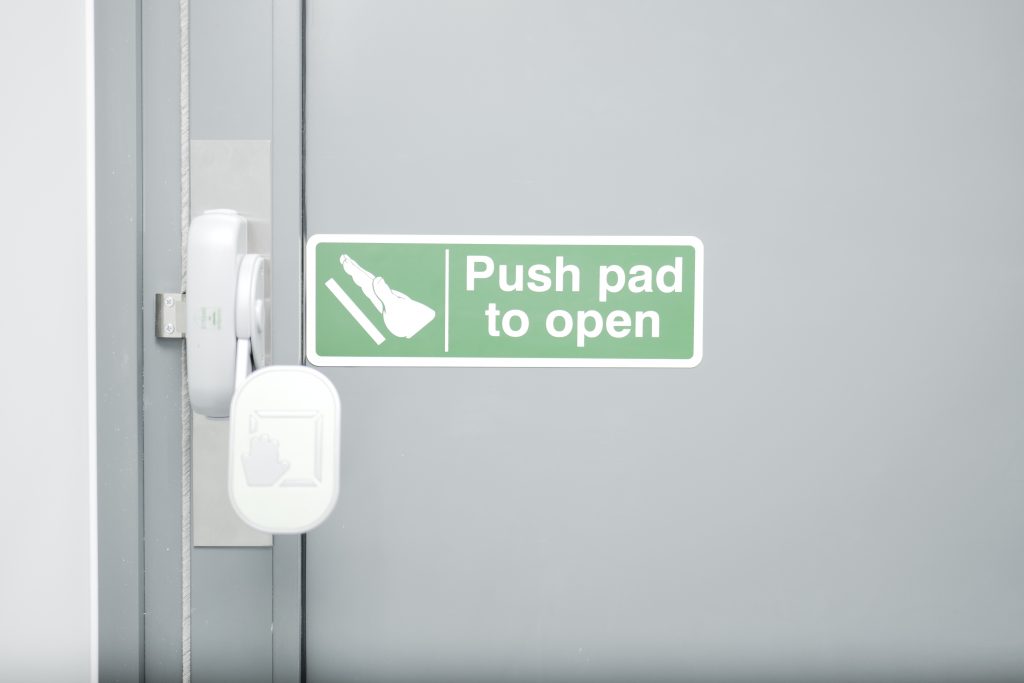Louise Frost from Door Controls Direct is here to take you on a whistle-stop tour of emergency exit hardware, providing guidance and support to keep buildings safe and secure.
Panic and emergency exit hardware provides swift, intuitive egress during emergencies. By activating a horizontal bar, push pad, or lever, a mechanism is triggered to open the door. This straightforward operation avoids confusion during critical moments, reducing risks in crowded environments.
Locksmiths regularly encounter panic hardware and emergency exit devices that secure buildings and protect occupants. You will have seen crash bars on final exit doors, with Push Bar to Open signage so we’ll skip the basics and explain it in a little more detail.
Familiarity with the variations, applications, and standards is key to ensuring correct installation, maintenance, and safety for users when it comes to items of life safety hardware. With regulations being regularly reviewed and updated, make sure you know when to fit a push bar instead of a push pad, and why.
Standards Locksmiths Should Know
Compliance isn’t optional. Panic hardware must meet one of two British standards:
- BS EN 1125: Public-access buildings require panic bars for single action, rapid evacuation. Install anywhere where occupancy exceeds 60 people.
- BS EN 179: Office-type environments, where occupants know the layout and hardware, can use push pads. The occupancy must be under 60 people.
All devices must display the CE mark, confirming testing and conformity with the relevant standard.
Common Types and Uses
Panic Bars
Panic bars or crash bars come in two common variations – push bars or touch bars. Install to outward opening doors. Products will have been successfully type-tested for conformity to the requirements of BS EN 1125.
Push Pad and Lever Handles
Push pads suit facilities used by trained staff, compliant with BS EN 179. Pull pads and lever handles are other viable items of emergency exit hardware but have different activation methods – pull or lever action, not push.
Outside Access Devices
Where external access is required to these normally locked doors, a lever or knob-operated outside access device (OAD) can be installed. They can be secured by key, cylinder, or code.
Door Latching
Panic bars and push pads can incorporate a bevelled latch bolt for single point locking. Mortice night latches conceal the latch bolt in the door frame when closed, for additional protection from tampering. Pullman latches are horizontal or vertical latches that provide additional locking points with a smooth, quiet operation.
Vertical Rods
Hardware with vertical rods secure the door at the top and bottom. Surface-mounted rods are easy to fit and maintain. Concealed rods provide a neat appearance and are suitable for aluminium doors. Combine rods with a horizontal latch for 3-point locking.
Choosing the Correct Hardware
Selecting the appropriate panic hardware involves several considerations:
- Users: Public or trained employees? 60 or more occupants?
- Door Specifics: Height, width, thickness, and weight. Single, double, or rebated? Timber or metal? Inward or outward opening?
- Security Needs: Is additional security or outside access required?
Installation Best Practice
Careful installation ensures long-lasting hardware and delivers compliance with relevant legislation:
- Use manufacturer templates and instructions to ensure accurate fitting.
- Check device compatibility with existing components like door closers.
- Precisely align strike plates, rods, and latches.
- Fit all accompanying signage.
- Test mechanism operation after installation.
- Clearly instruct users or building management on the correct operation and guide them on the required routine checks.
Routine Maintenance
Regular, preventative maintenance keeps hardware effective and prolongs its lifespan:
- Inspect rods, latches, and bolts periodically, for wear and tear or signs of tampering.
- A weekly operational test for ease of operation.
- Check the door alignment.
- Immediately repair or replace components showing wear or damage.
Your Role Matters
Your expertise in panic hardware directly impacts building safety. Regular training, adherence to standards and regulations, plus accurate installation and on-going maintenance, aids in safeguarding occupants.
Keeping updated on hardware and regulations ensures your customers trust your services and are safe in their surroundings. Reduce callbacks and unnecessary maintenance by selecting and installing the right product for the right job first time round.
At Door Controls Direct, we are here to aid in compliance and safety with our reliable fire door and exit solutions. We are here to help you Protect What Matters.



